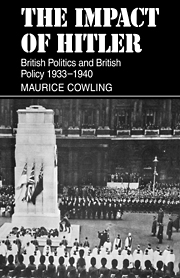Book contents
Chamberlain and the war
Published online by Cambridge University Press: 19 October 2009
Summary
‘The way to win the war is to convince the Germans that they cannot win’.
Chamberlain to Ida, September 23 1939‘As you know I have always been more afraid of a peace offer than of an air raid’.
Chamberlain to Ida, October 8 1939‘I stick to the view I have always held that Hitler missed the bus in September 1938. He could have dealt France and ourselves a terrible, perhaps a mortal, blow then. The opportunity will not recur’.
Chamberlain to Hilda, December 30 1939When Chamberlain agreed that war should be declared, he intended to meet any threat Hitler might offer in the air and to take any opportunities that might arise to sink such parts of the German navy as offered themselves to attack. There was no expectation of military victory and no real belief that the state of war need be turned into a war of steel and blood. Fortified by the neutrality of Italy and Japan and unimpressed by the Russo-German alliance, he believed that Hitler's bluff had been called. The French defences presented a deterrent in the West. Anglo-French effort could be directed at producing a collapse of the German home front as the German people came to understand that Hitler could not win.
Nor was this passive conception an aberration. The guarantee to Poland, so far from implying a will to fight, had been intended to make fighting unnecessary. Hitler had not been deterred, but he had had to ally himself with the Soviet Union.
- Type
- Chapter
- Information
- The Impact of HitlerBritish Politics and British Policy 1933-1940, pp. 355 - 366Publisher: Cambridge University PressPrint publication year: 1975
- 2
- Cited by



